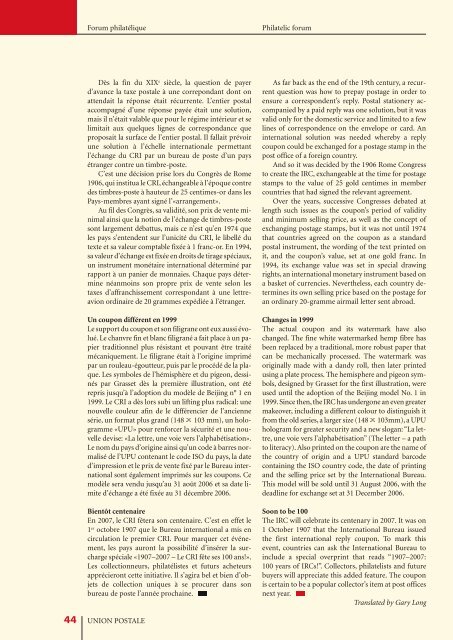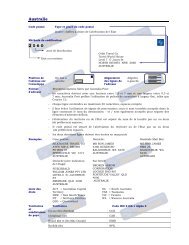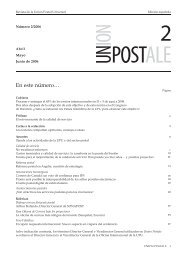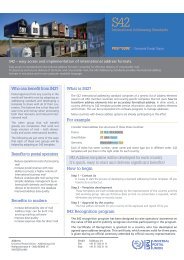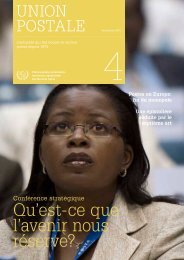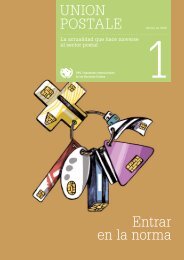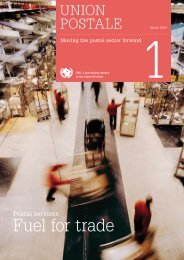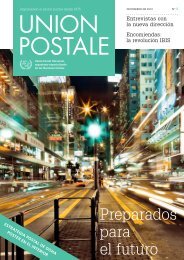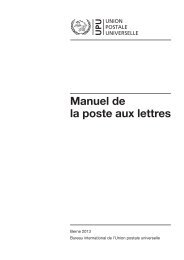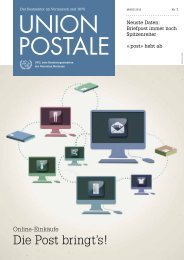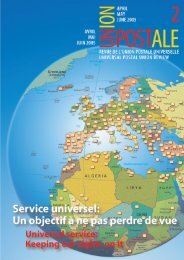Union Postale, revue de l'Union postale universelle - UPU ...
Union Postale, revue de l'Union postale universelle - UPU ...
Union Postale, revue de l'Union postale universelle - UPU ...
- No tags were found...
You also want an ePaper? Increase the reach of your titles
YUMPU automatically turns print PDFs into web optimized ePapers that Google loves.
Forum philatéliquePhilatelic forum44Dès la fin du XIX e siècle, la question <strong>de</strong> payerd’avance la taxe <strong>postale</strong> à une correpondant dont onattendait la réponse était récurrente. L’entier postalaccompagné d’une réponse payée était une solution,mais il n’était valable que pour le régime intérieur et selimitait aux quelques lignes <strong>de</strong> correspondance queproposait la surface <strong>de</strong> l’entier postal. Il fallait prévoirune solution à l’échelle internationale permettantl’échange du CRI par un bureau <strong>de</strong> poste d’un paysétranger contre un timbre-poste.C’est une décision prise lors du Congrès <strong>de</strong> Rome1906, qui institua le CRI, échangeable à l’époque contre<strong>de</strong>s timbres-poste à hauteur <strong>de</strong> 25 centimes-or dans lesPays-membres ayant signé l’«arrangement».Au fil <strong>de</strong>s Congrès, sa validité, son prix <strong>de</strong> vente minimalainsi que la notion <strong>de</strong> l’échange <strong>de</strong> timbres-postesont largement débattus, mais ce n’est qu’en 1974 queles pays s’enten<strong>de</strong>nt sur l’unicité du CRI, le libellé dutexte et sa valeur comptable fixée à 1 franc-or. En 1994,sa valeur d’échange est fixée en droits <strong>de</strong> tirage spéciaux,un instrument monétaire international déterminé parrapport à un panier <strong>de</strong> monnaies. Chaque pays déterminenéanmoins son propre prix <strong>de</strong> vente selon lestaxes d’affranchissement correspondant à une lettreavionordinaire <strong>de</strong> 20 grammes expédiée à l’étranger.Un coupon différent en 1999Le support du coupon et son filigrane ont eux aussi évolué.Le chanvre fin et blanc filigrané a fait place à un papiertraditionnel plus résistant et pouvant être traitémécaniquement. Le filigrane était à l’origine imprimépar un rouleau-égoutteur, puis par le procédé <strong>de</strong> la plaque.Les symboles <strong>de</strong> l’hémisphère et du pigeon, <strong>de</strong>ssinéspar Grasset dès la première illustration, ont étérepris jusqu’à l’adoption du modèle <strong>de</strong> Beijing n° 1 en1999. Le CRI a dès lors subi un lifting plus radical: unenouvelle couleur afin <strong>de</strong> le différencier <strong>de</strong> l’anciennesérie, un format plus grand (148 u 103 mm), un hologramme«<strong>UPU</strong>» pour renforcer la sécurité et une nouvelle<strong>de</strong>vise: «La lettre, une voie vers l’alphabétisation».Le nom du pays d’origine ainsi qu’un co<strong>de</strong> à barres normalisé<strong>de</strong> l’<strong>UPU</strong> contenant le co<strong>de</strong> ISO du pays, la dated’impression et le prix <strong>de</strong> vente fixé par le Bureau internationalsont également imprimés sur les coupons. Cemodèle sera vendu jusqu’au 31 août 2006 et sa date limited’échange a été fixée au 31 décembre 2006.Bientôt centenaireEn 2007, le CRI fêtera son centenaire. C’est en effet le1 er octobre 1907 que le Bureau international a mis encirculation le premier CRI. Pour marquer cet événement,les pays auront la possibilité d’insérer la surchargespéciale «1907–2007 – Le CRI fête ses 100 ans!».Les collectionneurs, philatélistes et futurs acheteursapprécieront cette initiative. Il s’agira bel et bien d’objets<strong>de</strong> collection uniques à se procurer dans sonbureau <strong>de</strong> poste l’année prochaine. JUNION POSTALEAs far back as the end of the 19th century, a recurrentquestion was how to prepay postage in or<strong>de</strong>r toensure a correspon<strong>de</strong>nt’s reply. Postal stationery accompaniedby a paid reply was one solution, but it wasvalid only for the domestic service and limited to a fewlines of correspon<strong>de</strong>nce on the envelope or card. Aninternational solution was nee<strong>de</strong>d whereby a replycoupon could be exchanged for a postage stamp in thepost office of a foreign country.And so it was <strong>de</strong>ci<strong>de</strong>d by the 1906 Rome Congressto create the IRC, exchangeable at the time for postagestamps to the value of 25 gold centimes in membercountries that had signed the relevant agreement.Over the years, successive Congresses <strong>de</strong>bated atlength such issues as the coupon’s period of validityand minimum selling price, as well as the concept ofexchanging postage stamps, but it was not until 1974that countries agreed on the coupon as a standardpostal instrument, the wording of the text printed onit, and the coupon’s value, set at one gold franc. In1994, its exchange value was set in special drawingrights, an international monetary instrument based ona basket of currencies. Nevertheless, each country <strong>de</strong>terminesits own selling price based on the postage foran ordinary 20-gramme airmail letter sent abroad.Changes in 1999The actual coupon and its watermark have alsochanged. The fine white watermarked hemp fibre hasbeen replaced by a traditional, more robust paper thatcan be mechanically processed. The watermark wasoriginally ma<strong>de</strong> with a dandy roll, then later printedusing a plate process. The hemisphere and pigeon symbols,<strong>de</strong>signed by Grasset for the first illustration, wereused until the adoption of the Beijing mo<strong>de</strong>l No. 1 in1999. Since then, the IRC has un<strong>de</strong>rgone an even greatermakeover, including a different colour to distinguish itfrom the old series, a larger size (148 u 103mm), a <strong>UPU</strong>hologram for greater security and a new slogan: “La lettre,une voie vers l’alphabétisation” (The letter – a pathto literacy). Also printed on the coupon are the name ofthe country of origin and a <strong>UPU</strong> standard barco<strong>de</strong>containing the ISO country co<strong>de</strong>, the date of printingand the selling price set by the International Bureau.This mo<strong>de</strong>l will be sold until 31 August 2006, with the<strong>de</strong>adline for exchange set at 31 December 2006.Soon to be 100The IRC will celebrate its centenary in 2007. It was on1 October 1907 that the International Bureau issuedthe first international reply coupon. To mark thisevent, countries can ask the International Bureau toinclu<strong>de</strong> a special overprint that reads “1907–2007:100 years of IRCs!”. Collectors, philatelists and futurebuyers will appreciate this ad<strong>de</strong>d feature. The couponis certain to be a popular collector’s item at post officesnext year. JTranslated by Gary Long


